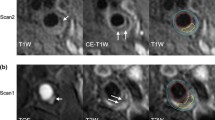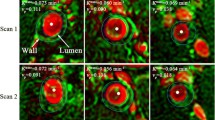Abstract
Objectives
This study aims to evaluate the reproducibility of measures of plaque morphology in serially acquired black-blood MRI of untreated atherosclerotic femoral arteries.
Materials and methods
MR studies was obtained from 42 timepoints, on 12 patients with known femoral artery atherosclerosis. Images with a 3D isotropic FLASH with DANTE-prepared black blood contrast (DASH) at a 3-T scanner were acquired at baseline, within 1 week, and at 1 month. Six of the patients were scanned additionally at 6 months. Inter-scan and inter-observer variations of arterial area/volume measurements were evaluated.
Results
Measurement of vessel area, lumen area, wall area and wall volume showed inter-scan intraclass correlation coefficients (ICC) ranging from 0.92 to 0.97 for 3 scans, 0.91–0.97 for 4 scans, and inter-observer ICCs of 0.89–0.96. Among 3 scans, the coefficients of variance (CV) for the vessel area, lumen area, wall area and wall volume were 4.1%, 6.5%, 7.5%, and 4.4%. CVs among 4 scans ranged from 4.4% to 7.9%, and interobserver CVs ranged from 6.1% to 11.8% for the different area/volume measurements.
Conclusion
DASH MRI is useful for quantifying atherosclerotic vessel area and volume of femoral arteries with low variability among serial repeated scans and between observers.



Similar content being viewed by others
References
Belch JJ, Topol EJ, Agnelli G, Bertrand M, Califf RM, Clement DL, Creager MA, Easton JD, Gavin JR 3rd, Greenland P, Hankey G, Hanrath P, Hirsch AT, Meyer J, Smith SC, Sullivan F, Weber MA, Prevention of Atherothrombotic Disease N (2003) Critical issues in peripheral arterial disease detection and management: a call to action. Arch Intern Med 163(8):884–892
Wang Y, Xu Y, Li J, Wei Y, Zhao D, Hou L, Hasimu B, Yang J, Yuan H, Hu D (2010) Characteristics of prevalence in peripheral arterial disease and correlative risk factors and comorbidities among female natural population in China. Vasa 39(4):305–311
Criqui MH, Langer RD, Fronek A, Feigelson HS, Klauber MR, McCann TJ, Browner D (1992) Mortality over a period of 10 years in patients with peripheral arterial disease. N Engl J Med 326(6):381–386
Hirsch AT, Allison MA, Gomes AS, Corriere MA, Duval S, Ershow AG, Hiatt WR, Karas RH, Lovell MB, McDermott MM, Mendes DM, Nussmeier NA, Treat-Jacobson D, American Heart Association Council on Peripheral Vascular D, Council on Cardiovascular N, Council on Cardiovascular R, Intervention, Council on Cardiovascular S, Anesthesia, Council on Clinical C, Council on E, Prevention (2012) A call to action: women and peripheral artery disease: a scientific statement from the American Heart Association. Circulation 125(11):1449–1472
Joosten MM, Pai JK, Bertoia ML, Rimm EB, Spiegelman D, Mittleman MA, Mukamal KJ (2012) Associations between conventional cardiovascular risk factors and risk of peripheral artery disease in men. JAMA 308(16):1660–1667
Kim ES, Wattanakit K, Gornik HL (2012) Using the ankle-brachial index to diagnose peripheral artery disease and assess cardiovascular risk. Cleve Clin J Med 79(9):651–661
Walsh DB, Powell RJ, Stukel TA, Henderson EL, Cronenwett JL (1997) Superficial femoral artery stenoses: characteristics of progressing lesions. J Vasc Surg 25(3):512–521
Matsuo Y, Takumi T, Mathew V, Chung WY, Barsness GW, Rihal CS, Gulati R, McCue ET, Holmes DR, Eeckhout E, Lennon RJ, Lerman LO, Lerman A (2012) Plaque characteristics and arterial remodeling in coronary and peripheral arterial systems. Atherosclerosis 223(2):365–371
Isbell DC, Meyer CH, Rogers WJ, Epstein FH, DiMaria JM, Harthun NL, Wang H, Kramer CM (2007) Reproducibility and reliability of atherosclerotic plaque volume measurements in peripheral arterial disease with cardiovascular magnetic resonance. J Cardiovasc Magn Reson 9(1):71–76
Adams GJ, Greene J, Vick GW 3rd, Harrist R, Kimball KT, Karmonik C, Ballantyne CM, Insull W Jr, Morrisett JD (2004) Tracking regression and progression of atherosclerosis in human carotid arteries using high-resolution magnetic resonance imaging. Magn Reson Imaging 22(9):1249–1258
El Aidi H, Mani V, Weinshelbaum KB, Aguiar SH, Taniguchi H, Postley JE, Samber DD, Cohen EI, Stern J, van der Geest RJ, Reiber JH, Woodward M, Fuster V, Gidding SS, Fayad ZA (2009) Cross-sectional, prospective study of MRI reproducibility in the assessment of plaque burden of the carotid arteries and aorta. Nat Clin Pract Cardiovasc Med 6(3):219–228
Chiu B, Sun J, Zhao X, Wang J, Balu N, Chi J, Xu J, Yuan C, Kerwin WS (2011) Fast plaque burden assessment of the femoral artery using 3D black-blood MRI and automated segmentation. Med Phys 38(10):5370–5384
Quick HH, Debatin JF, Ladd ME (2002) MR imaging of the vessel wall. Eur Radiol 12(4):889–900
Yuan C, Mitsumori LM, Beach KW, Maravilla KR (2001) Carotid atherosclerotic plaque: noninvasive MR characterization and identification of vulnerable lesions. Radiology 221(2):285–299
Fayad ZA, Fuster V, Fallon JT, Jayasundera T, Worthley SG, Helft G, Aguinaldo JG, Badimon JJ, Sharma SK (2000) Noninvasive in vivo human coronary artery lumen and wall imaging using black-blood magnetic resonance imaging. Circulation 102(5):506–510
Chi J, Chiu B, Cao Y, Liu X, Wang J, Balu N, Yuan C, Xu J (2013) Assessment of femoral artery atherosclerosis at the adductor canal using 3D black-blood MRI. Clin Radiol 68(4):e213–221
Li L, Miller KL, Jezzard P (2012) DANTE-prepared pulse trains: a novel approach to motion-sensitized and motion-suppressed quantitative magnetic resonance imaging. Magn Reson Med 68(5):1423–1438
Li L, Chai JT, Biasiolli L, Robson MD, Choudhury RP, Handa AI, Near J, Jezzard P (2014) Black-blood multicontrast imaging of carotid arteries with DANTE-prepared 2D and 3D MR imaging. Radiology 273(2):560–569
Xie G, Zhang N, Xie Y, Nguyen C, Deng Z, Bi X, Fan Z, Liu X, Li D, Fan Z (2016) DANTE-prepared three-dimensional FLASH: A fast isotropic-resolution MR approach to morphological evaluation of the peripheral arterial wall at 3 Tesla. J Magn Reson Imaging 43(2):343–351
Han Y, Guan M, Zhu Z, Li D, Chen H, Yuan C, Li C, Wang W, Zhao X (2018) Assessment of longitudinal distribution of subclinical atherosclerosis in femoral arteries by three-dimensional cardiovascular magnetic resonance vessel wall imaging. J Cardiovasc Magn Reson 20(1):60
Langham MC, Desjardins B, Englund EK, Mohler ER 3rd, Floyd TF, Wehrli FW (2016) Rapid high-resolution, self-registered, dual lumen-contrast MRI method for vessel-wall assessment in peripheral artery disease: a preliminary investigation. Acad Radiol 23(4):457–467
Koo TK, Li MY (2016) A guideline of selecting and reporting intraclass correlation coefficients for reliability research. J Chiropr Med 15(2):155–163
Bland JM, Altman DG (1986) Statistical methods for assessing agreement between two methods of clinical measurement. Lancet 1(8476):307–310
Whitley E, Ball J (2002) Statistics review 4: sample size calculations. Crit Care 6(4):335–341
Corti R, Fuster V, Fayad ZA, Worthley SG, Helft G, Smith D, Weinberger J, Wentzel J, Mizsei G, Mercuri M, Badimon JJ (2002) Lipid lowering by simvastatin induces regression of human atherosclerotic lesions: two years' follow-up by high-resolution noninvasive magnetic resonance imaging. Circulation 106(23):2884–2887
Wyttenbach R, Corti R, Alerci M, Cozzi L, Di Valentino M, Segatto JM, Badimon JJ, Fuster V, Gallino A (2007) Effects of percutaneous transluminal angioplasty and endovascular brachytherapy on vascular remodeling of human femoropopliteal artery: 2 years follow-up by noninvasive magnetic resonance imaging. Eur J Vasc Endovasc Surg 34(4):416–423
Laird JR, Yeo KK (2012) The treatment of femoropopliteal in-stent restenosis: back to the future. J Am Coll Cardiol 59(1):24–25
Bianda N, Di Valentino M, Periat D, Segatto JM, Oberson M, Moccetti M, Sudano I, Santini P, Limoni C, Froio A, Stuber M, Corti R, Gallino A, Wyttenbach R (2012) Progression of human carotid and femoral atherosclerosis: a prospective follow-up study by magnetic resonance vessel wall imaging. Eur Heart J 33(2):230–237
Funding
This study was supported by United States National Institutes of Health (Grant numbers R01HL128816-01).
Author information
Authors and Affiliations
Contributions
Study conception and design: DS, YW, XL, TH. Acquisition of data: HH, CZ, MB, WG. Analysis and interpretation of data: YW, XL. Drafting of manuscript: YW. Critical revision: DS.
Corresponding author
Ethics declarations
Conflict of interest
The authors declare no conflict of interest.
Ethical approval
The institutional review board of the University of California San Francisco approved this prospective study (ClinicalTrials.gov Identifier: NCT02807779). Written consent was obtained from each patient.
Additional information
Publisher's Note
Springer Nature remains neutral with regard to jurisdictional claims in published maps and institutional affiliations.
Rights and permissions
About this article
Cite this article
Wang, Y., Liu, X., Haraldsson, H. et al. Quantitative measurement of atheroma burden: reproducibility in serial studies of atherosclerotic femoral arteries. Magn Reson Mater Phy 33, 855–863 (2020). https://doi.org/10.1007/s10334-020-00843-7
Received:
Revised:
Accepted:
Published:
Issue Date:
DOI: https://doi.org/10.1007/s10334-020-00843-7




